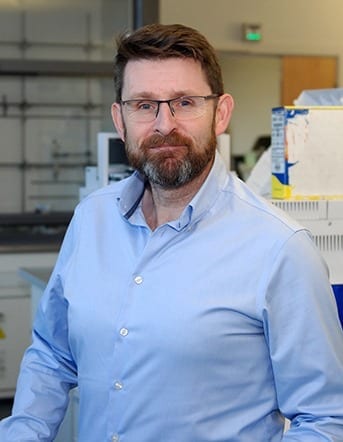
The research could lead to huge economic gains in the pharmaceutical and agrichemical sectors, plus more affordable medicines for healthcare providers.
“…new iron catalysed reaction could prove to be a thousand times cheaper than an equivalent process…”
SCIENTISTS at the University of Huddersfield have developed a new chemical reaction that is catalysed using simple iron salts – an inexpensive, abundant and sustainable alternative to costlier and scarcer metals. The research could lead to huge economic gains in the pharmaceutical and agrichemical sectors, plus more affordable medicines for healthcare providers. It is described in a new article published by one of the world’s leading scientific journals.
The core reaction developed by the Huddersfield team has been patented, and research continues, with further publication in the pipeline. “Also, we are keen to establish connectivity with companies, so we can get these compounds out into industry as quickly as possible,” said project leader Joe Sweeney, who is Professor of Catalysis and Chemical Biology at the University.
His co-researchers and authors for the article that appears in the journal Nature Chemistry include fellow members of the academic staff at the University’s Department of Chemistry, plus talented research students.
Catalysis is an essential component of the chemical industry. It has been estimated that it underpins as much as 40 per cent of the world’s GDP. It is also the subject of intense academic investigation, meaning that the breakthrough by Professor Sweeney’s group is of exceptional scientific as well as industrial significance.
“Most of the catalytes that are in current use are so-called scarce metals such as rhodium, palladium, platinum or iridium,” said Professor Sweeney. “The advantage is that they are usually very active, so they can mediate reactions quicker and at a lower catalytic loading.
“But if you look at tables of abundance in the earth’s crust, these metals are all right at the bottom, so there has been a big push towards devising catalytic processes that use more sustainable catalysts, such as iron, which is probably the most abundant metal.”
The new Nature Chemistry article is a detailed description of an efficient and sustainable new iron catalyse reaction that could prove to be a thousand times cheaper than an equivalent process using scarce and costly metals. A further advantage is that iron – which plays a fundamental part in diet – is considered non-toxic.
The new process is highly accessible, said Professor Sweeney. “A key driver of organic chemistry is that it should be practical and shouldn’t require esoteric conditions. Our process is carried out using standard apparatus in a standard laboratory at room temperature. That is kind of the benchmark for organic chemistry.”
The research group has included experts from the key chemistry disciplines. An important part was played by Dr Nathan Patmore, an inorganic chemist whose collaboration helped establish the mechanism of the iron process.
Learn more: Scientists develop new catalysed reaction using iron salts
[osd_subscribe categories=’catalyst’ placeholder=’Email Address’ button_text=’Subscribe Now for any new posts on the topic “CATALYST”‘]
Receive an email update when we add a new CATALYST article.
The Latest on: New catalysed reaction
[google_news title=”” keyword=”new catalysed reaction” num_posts=”10″ blurb_length=”0″ show_thumb=”left”]
via Google News
The Latest on: New catalysed reaction
- Revolutionizing Catalyst Design: New Research Links Structure to Reaction Performanceon May 6, 2024 at 4:12 pm
In a significant advance in the fight against climate change and the shift towards sustainability, a team of researchers has introduced a new research framework that simplifies understanding how ...
- Mechanochemical reaction oxidizes C–H bonds in polymerson May 5, 2024 at 5:00 pm
In addition to investigating the properties of the partially oxidized polymers, the authors of the new study plan to test the reaction on lignocellulose, one of the most common forms of waste biomass ...
- At the Edge of Explosion: How New Science Is Making Old Reactions Saferon May 5, 2024 at 2:32 pm
The chemical industry has been using a reaction with explosive chemicals for over 100 years — now Mülheim scientists have discovered a safer alternative. Explosions and poisoning. Serious injuries and ...
- Comedian leaves the internet in stitches by sharing her honest reactions to the filthy bedrooms of men in New Yorkon May 3, 2024 at 7:32 am
The images that come to mind when picturing a single man's room are vivid - often provoking a visceral reaction to those who ... Bemused and intrigued by men in New York and the habitats they ...
- The new drugs preventing allergic reactions to peanuts and other foodson May 2, 2024 at 1:44 pm
Incredible results from trials of several new medications show they can prevent potentially deadly reactions to foods like peanuts, eggs and dairy - and may one day treat asthma ...
- New approach in the synthesis of complex natural substanceson May 1, 2024 at 5:00 pm
They are found as fragrances in cosmetics or as flavorings in food, and form the basis of new medications: Terpenes are natural substances that occur in plants, insects and sea sponges. They are ...
- Tom Brady Is Forced to Choose Between Tampa Bay and New England in New Ads — See His Reaction!on May 1, 2024 at 6:01 am
Brady won six Super Bowls in New England before his departure to Tampa Bay, where he won a seventh championship in 2021 Natasha Dye is a writer-reporter for PEOPLE covering sports. Her previous ...
- Pro-Palestinian protests spread, get more heated as schools' reactions differon April 30, 2024 at 8:38 pm
In an extraordinary scene, New York City police officers entered the Columbia University campus Tuesday night after dozens of protesters took over a campus building in New York, barricading the ...
- Taylor Swift fans share raw reactions to her new album as psychologist weighs in: ‘Explores dark places’on April 30, 2024 at 2:00 am
Thousands of videos pop up on TikTok from a search for "TTPD reaction," as Swifties share their initial thoughts and feelings about the 31 new songs. Amid the live reactions across social media ...
via Bing News










